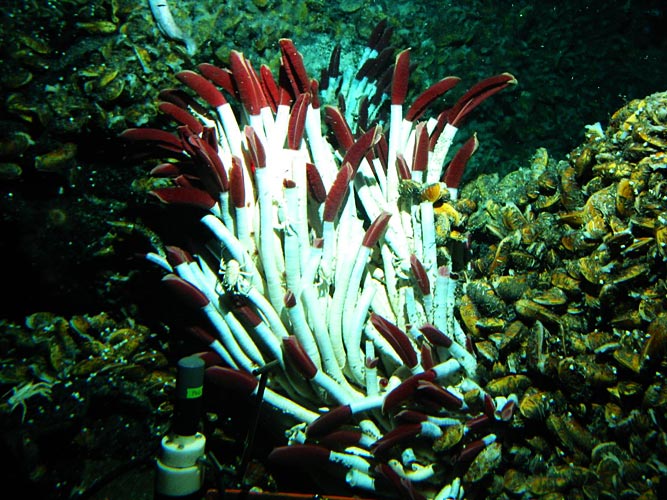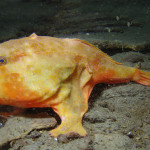by Kevin Zelnio

#24 Tubeworms (Phylum Annelida, Class Polychaeta, Order Canalipalpata, Family Siboglinidae)
Worms in a tube, what could be more fun! How about worms in a tube that do not have a mouth, digestive track or anus? Still not fun? Add on a highly vascularized plume that binds oxygen, carbon dioxide and toxic hydrogen sulfide (also known as rotten egg gas) and delivers it all to a sack of bacteria it keeps inside of it. This bacteria are able to use the carbon dioxide as a carbon substrate and the hydrogen sulfide as an energy source. Yes, it uses an asphyxiating, rancid-smelling gas for energy instead of eating other stuff (us) or using sunlight (plants). The byproducts of bacterial metabolism include simple carbon compounds that the worm itself can use as an energy source.
The hydrothermal vent tubeworm Riftia pachyptila (above) can grow in excess of 2 meters (taller than me…), buts its body only occupies the upper portion of the tube. The methane seep tubeworm, Lamellibrachia luymesi (below), can grow to be nearly 2 meters in length above the ground. Its butt end grows down into carbonate rock (below right) and sediment to mine sulfide. Total length is hard to determine since the "roots" of the tubeworm are fragile and break off easily, but could be just as long below ground as above ground. Thats a long worm!
Research and modeling has shown that Lamellibrachia can live a looooong time too, up to 200-300 years. It was thought to be the longest lived non-colonial/clonal animal until a recent discovery of a deep sea clam. Their lifespan may be extended by mining of sediment for sulfide, but also by getting rid of the waste products (sulfate) which could in turn fuel the microbial inhabitants that produce sulfide as their own waste product. So it appears these guys have devised a nice engineering solution to their food and energy needs. A perpetual nutrient recycling machine.
Tubeworms: no gut, mouth or butt; can handle and deliver toxic hydrogen sulfide to its bacterial friends; grow very long, can live very long and are smart engineers!


Pictures of Lamellibrachia luymesi "bush" taken by me during a 2004 cruise to methane seeps in the Gulf of Mexico. This was my first mass murder collection of tubeworms! The "rootball" on the right shows how tightly wound around the rock they were, so much so that the rock came up with the collection!






Nice bush Kevin! How big is that 3/4m?
Is the riftittia image from one of your cruises as well? If so what is the sensor in the lower left edge?
I once used tube worms as the basis for a race of deep-dwelling water dwarves for a game of Dungeon & Dragons. The red-skinned race dwelt near hydrothermal vents, using the black smokers as organic forges where they manufactured calciferous weapons and armor. Over time, the race had adapted to their domain, becoming chemosynthetic.
I’m personally offended that the tubeworm didn’t make it higher, Kevin. Especially in light of Aeolius’ comment. Didn’t qualify as “charasmatic megafauna”?
For the record, Craig ordered the list…
Also for the record, This will be an backboneless list as far I’m concerned!
Dr Cords,
Everything ends up in my undersea D&D game, before long, as I tend to amalgamate my hobbies. I have blinogo (sea goblins) fashioned after goblin sharks, iblishi (sea kobolds) fashioned after blue-spot stingrays, krana (sea orcs) fashioned from black chimaera, and kolocanth (sea bugbears) fashioned from coelacanth, to name a few.
I wonder how many years we’ll have to wait, until someone perfects a deep-sea aquarium. Specimens could be collected and kept at the appropriate pressure, with ROVs taking care of tank maintenance and a pressure-lock attached for feeding/new specimens.